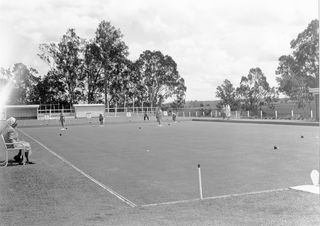

There Was Once an Asylum



This site not only provides an overview of mental health history and its implications for Goodna, but also explores the complex relationship between memory and history
There are stories we may never know, but this site uncovers the history, revealing the layers of understanding that form the foundation of the present.
It is done in a way that honours the patients, clients, and the people.
Female Patients Recreation Area and Early Asylum Site
The Female Patients Recreation Area and Early Asylum Site is an area of open ground to the southwest of the Female Patient Area,
stretching along the Brisbane River and bounded by Woogaroo Creek to the south.
The features of the Female Patients' Recreation Area and Early Asylum Site of state-level significance include
-
Layout of Buildings and Landscapes, Views
-
Recreation Grounds (1951-5)
-
Cafeteria (c1951)
-
Change Room and Stores Shed (c1951)
-
Packing Shed and Patients Shelter (c1951)
-
Early Asylum Site (1865), including former Simpson Residence Site (1843-44)
The layout of Buildings and Landscapes,
The Female Patients Recreation Area comprises buildings (a Cafeteria, Bowling Green, Change Room and Stores Shed) laid out along a curved ridge that forms a natural amphitheatre around former playing fields on the lower terrace at the edge of the Brisbane River.
A further building (Packing Shed and Patients Shelter) stands southwest of the others and overlooks the sloping ground to the south that was historically an area for the cultivation of vegetables. Developed on the site of the former Simpson Residence (1843-44) and the subsequent Early Asylum Site (former Woogaroo Insane Asylum, established 1865, demolished 1890-93 floods), the area now forms part of the Wolston Park Golf Club course (1970s), which contributes to the spacious open grounds and landscape setting of the hospital complex.
The views of state-level cultural heritage significance include:
-
The visual connection between the Cafeteria and the Female Wards 1 & 2 on the higher ground to the northeast, across the open former playing fields and terraces
-
Panoramic views from the cafeteria and from along the ridgeline, spanning northeast to northwest, taking in the park-like character of the open former playing fields and the bushland fringe and the river
-
From the Packing Shed and immediate surrounds, south across the sloping former agricultural areas and towards Woogaroo Creek
-
From the early cemetery site (1860s) at the junction of the Brisbane River and Woogaroo Creek, across the river and beyond, from the west to the east, this view illustrates the historical isolation of the early asylum.
Recreation Grounds (1951-5)
Developed as a therapeutic environment for female patients in the 1950s, the park-like character, layout, and spatial setting of the Recreation Grounds are intact and uninterrupted by later development. Mature trees (some possibly dating to the Early Asylum era) are dotted throughout the area and clustered in the vicinity of the Cafeteria and Ellerton Drive. The former tennis court on the ridge and the shelter shed that stood in an arc around the level of the former playing fields are no longer extant.
Features of the Recreation Grounds of state-level cultural heritage significance also include
-
Sloped and levelled ground forms, open space, and the extent of the grounds
-
Open grassed park-like setting on the ridge and sloping northwest down to the Brisbane River
-
Gently sloping open space of the former vegetable and agriculture plots, extending south down to Woogaroo Creek
-
Natural river and creek edges, with bushland fringes
-
Former Bowling Green: open space with a level lawn area on the ridge to the west of the Change Room and store shed
-
Former playing fields: a large, levelled grassed area of open space extending from the sloping natural amphitheatre toward the riverbank, with a line of evenly spaced mature cocos palms along its northwest extent









